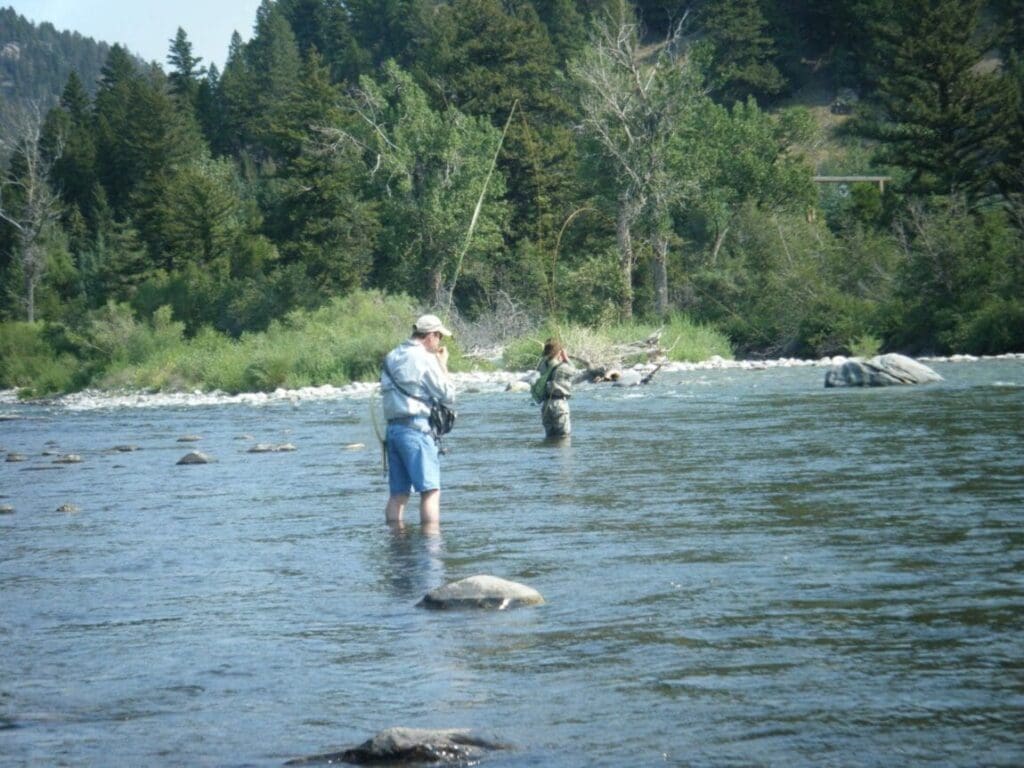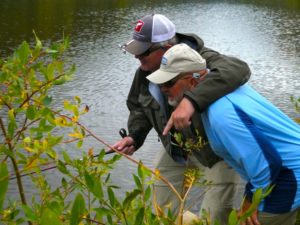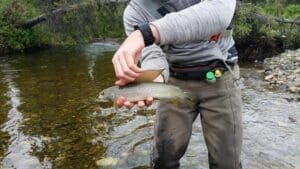Drag is not your friend:
One of the biggest mistakes I see on the water by our guys is allowing drag to destroy their drift. Drag is not your friend when it comes to dead drifting nymphs or dry flies. After working with new guys and watching “experienced” guys, I feel that many still don’t know what drag looks like on their fly. Eliminate the drag and catch more fish – simple.
The main cause of drag on your fly is your floating fly line. Your floating fly line will travel faster in the current than the current on the bottom of the stream. As the current pulls your fly line through the water it makes your fly travel underwater (or on top if you are dry fly fishing) faster than the natural drift of the actual aquatic insects below the surface. This will usually cause the trout to reject your fly. So, what can we do to get a “better” drift, a drift that will make your fly appear more natural underwater.
Talking about a proper mend with a student.
- Mend! Where have you heard that before? Many guys “think” they are mending well but unfortunately – not really. As soon as your indicator hits the water mend your ENTIRE fly line upstream. Too many guys do a “little” mend where the end of the fly line (nearest the indicator) never moves and it still leads the indicator downstream, i.e. pulling it too fast. When you mend, bring your rod tip up and around high to pick up the entire fly line to move it upstream. Try not to move your indicator while doing this. If the current is moving fast you may have to mend repeatedly before your dead drift is complete. Don’t wait too late to do this to keep a good dead drift throughout your drift.
- Let your indicator be your guide. Simply put, if your indicator is traveling on top of the water at a speed faster than the normal debris or foam that is also traveling on top of the water then you probably have drag on your fly. Your indicator should travel at the same speed as the debris or foam on top.
- Your dead drift is too short! Many guys accept a short drift which is usually caused by a poor mend or no second/third mend. With a short drift your flies may never reach the “target zone” on the bottom of the stream. Your flies need time to get down in the water column. If your line is pulling on your indicator (ahead of your indicator downstream) or there is a small wake behind your indicator, then you are no longer dead drifting. You might as well recast!
- You may need a split shot or two. The old saying goes, “the difference between a good nymph fly fisher and a great nymph fly fisher is just one split shot”. Why is this – because extra weight will get you down in the target zone faster and longer. Remember with extra weight on your flies or using split shot you may have to change the size of your indicator. A too small indicator for the amount of weight you added may pull your indicator down too far underwater to be “effective” and sense subtle strikes. Your indicator should just sit on top of the water.
- Try your hand at high sticking. High sticking, if done correctly, eliminates drag just by the technique alone. But so many guys do it incorrectly and still add drag to their flies when trying the high sticking technique. The idea behind high sticking is to have your fly line off the water allowing no way for your fly line to cause any drag on your fly. But just because your fly line is off the water doesn’t mean it is not adding drag to your fly. Your fly line needs to drop from your rod tip almost straight vertical towards the water. If the fly line “slopes” out from your rod tip to the indicator it could still be “pulling” on your fly. Also, your arm should be held high and stretched out but vertical to the water, so you can still have enough room to set the hook. If you do not use an indicator (example- euro nymphing) then the technique is slightly different.
- You may need to mend upstream and then downstream depending on your position in the current. If you are trying to dead drift in a fast current but have a slower current between you and the fast current. Then mend upstream near your indicator and “downstream” where you are standing in the slower current. Your mend will look like an S curve. The opposite is true if the currents are reversed. Ideally your fly line will become straight at the end of your drift as the two “S curves” come together.
- Learn how to “kick out” your line for a longer dead drift. To get a super long dead drift I will flick or kick out my fly line at the rod tip as my indicator passes me downstream. This creates a snake like wiggle in my fly line in the water near my rod tip. Then the S curves straighten out as the current pulls my fly line downstream without disturbing my indicator or dead drift.
Hopefully a few of these tips will help you maintain a good dead drift longer and increase your catch during your nymph and dry fly fishing. If something doesn’t make sense, please ask me to demo for you on the water. It’s the best way to learn.
Having a good drift will keep your net full!!!



